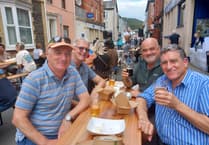The Aberystwyth Civic Society held its first meeting since the coronavirus pandemic struck over two years ago.
The meeting, on 10 September, was attended by more than 20 people, members of the society and those with an interest in Aberystwyth’s history.
Secretary Michael Freeman gave a guided tour of the old industrial part of Aberystwyth which began at what is now Plascrug Leisure Centre, where an old windmill once stood. Freeman believes it to have existed as late as 1830.
He told the group that the Eisteddfod had also once been held where the leisure centre’s playing fields sit today. Aberystwyth has hosted the Eisteddfod in 1952 and back in 1916.
At the cemetery on Plascrug Avenue, where Mr Freeman explained the rich and complicated history still visible in its design. The cemetery had once been split between “Anglican and dissident” — described at the time as being non-conformist Christians. The Anglican graves followed Christian customs and were buried in alignment with the Sun rising in the east and setting in the west, and “the grace of God” as it moved from east to west. “Dissident” plots were aligned north to south, exempting them from the tradition but serving still as a scar of a conflict long forgotten.
The tour then moved down Plascrug Avenue towards where the school stands today, leading down the park to what today is a bus station, but only as recently as 1990 would have been a row of shops, some of which once sold coal to townspeople, delivered by train to Aberystwyth station. At the time the station would have had railway lines covering the area that now houses Lidl and Morrisons.





Comments
This article has no comments yet. Be the first to leave a comment.